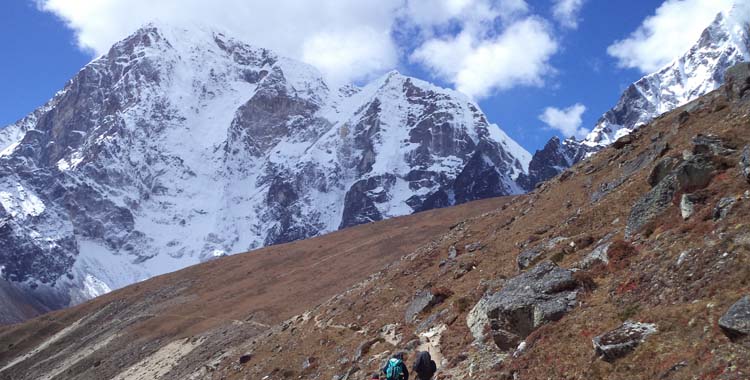
Everest Three Pass Trek 16 Days
Tour Gallery
Overview
Everest Three Pass Trek
Nestled in the heart of the majestic Himalayas, the Everest Three Pass Trek is a testament to the adventurous spirit of those seeking the thrill of high-altitude trekking.
This awe inspiring journey takes trekkers through some of the most breathtaking landscapes on Earth, providing an unforgettable experience that goes beyond the ordinary.
In this comprehensive guide, we will delve into the intricacies of the Everest Three Pass Trek. Exploring its challenges, rewards, and the magical allure that draws adventure enthusiasts from around the globe.
The Everest Three Pass Trek: An Overview
Route and Highlights
The Everest Three Pass Trek is a challenging yet advantageous trekking circuit in the Khumbu region of Nepal. The journey takes trekkers through the Everest Base Camp Trek, providing an up-close view of Mount Everest’s highest peak.
The three high passes Renjo La Pass, Cho La Pass, and Kongma La Pass are formidable challenges, offering panoramic views of the surrounding peaks and valleys. Trekkers encounter traditional Sherpa villages, ancient monasteries, and diverse flora and fauna along the way.
The Best Time to Trek The Everest Three Pass
Choosing the right time for the Everest Three Pass Trek is crucial for a successful and enjoyable experience. The primary trekking seasons are pre-monsoon (spring) from March to May and post-monsoon (autumn) from September to November.
The weather is relatively stable during these periods, offering clear skies and comfortable temperatures. Trekkers should avoid the monsoon season (June to August) and the harsh winter months (December to February). When the trails are often closed due to heavy snowfall.
The Three Passes: Challenges and Rewards
Renjo La Pass
At an elevation of 5,360 meters (17,585 feet), Renjo La Pass is the first challenge on the trek. The ascent to the pass is steep, but the panoramic views of Everest, Lhotse, and Cho Oyu make the effort worthwhile.
Trekkers can also enjoy the serene beauty of the Gokyo Lakes, a collection of turquoise glacial lakes nestled in the Gokyo Valley.
Cho La Pass
Standing at 5,420 meters (17,782 feet), Cho La Pass is a technical and demanding crossing that requires careful navigation through rocky terrain and crevasses.
Trekkers are rewarded with stunning views of Ama Dablam and other surrounding peaks. The descent from Cho La Pass leads to the iconic Everest Base Camp, where climbers prepare for their ascent to the summit.
Kongma La Pass
The final challenge, Kongma La Pass, is the highest of the three at 5,535 meters (18,159 feet). The ascent is strenuous, but the 360-degree views of the Himalayan giants, including Makalu and Lhotse Shar, are unparalleled.
The descent from Kongma La Pass brings trekkers to the tranquil village of Lobuche, marking the conclusion of the Three Pass adventure.
The Cultural Experience
Namche Bazaar
As the gateway to the Khumbu region, Namche Bazaar is a bustling market town and a hub for trekkers. Surrounded by snow capped peaks, Namche blends traditional Sherpa culture and modern amenities.
Trekkers acclimatize here before continuing their ascent, exploring local markets, and visiting the Hillary School, named after Sir Edmund Hillary, one of the first climbers to summit Everest.
Tengboche Monastery
Situated at 3,867 meters (12,687 feet), Tengboche Monastery is a spiritual sanctuary along the trek. The monastery, with its intricate wood carvings and stunning mountain backdrop, provides a glimpse into the rich Buddhist culture of the region.
Trekkers often witness traditional ceremonies and rituals, adding a spiritual dimension to their journey.
Flora and Fauna of the Khumbu Region
The Everest Three Pass Trek takes trekkers through various ecosystems, from lush rhododendron forests to alpine meadows.
The region is home to elusive wildlife such as the red panda, Himalayan tahr, and the elusive snow leopard. Bird enthusiasts will be delighted by sightings of colorful Himalayan monals and the national bird of Nepal, the Impeyan pheasant.
Practical Tips and Considerations
Physical Preparation
The Everest Three Pass Trek demands good physical fitness and endurance. Pre-trek training that includes cardiovascular exercises, strength training, and acclimatization hikes is crucial for a successful journey.
Additionally, mental resilience plays a significant role in overcoming the challenges of high-altitude trekking.
Permits and Regulations
Trekkers must obtain the necessary permits for the Everest Three Pass Trek, including the Sagarmatha National Park and Gokyo Lakes entry permits.
It’s essential to stay informed about local regulations and adhere to the principles of responsible trekking to minimize the environmental impact.
Accommodation and Amenities
Teahouses along the route provide basic accommodation and meals. It’s advisable to carry a good-quality sleeping bag and trekking gear suitable for varying weather conditions.
Trekkers should also have water purification tablets and avoid single-use plastics to contribute to the conservation of the pristine Himalayan environment.
Conclusion
The Everest Three Pass Trek is more than just a physical challenge. It’s a transformative journey that immerses trekkers in the awe-inspiring grandeur of the Himalayas. From the rugged mountain passes to the vibrant Sherpa culture, every step reveals a new facet of this extraordinary trek.
For those seeking an adventure that transcends the ordinary. The Everest Three Pass Trek is an invitation to explore the heights of nature’s beauty and the depths of personal resilience. Lace up your boots, breathe in the crisp mountain air, and embark on an odyssey that will leave an indelible mark on your soul.
Trip Highlights
- ☞Everest Three Pass Trekking is rated as a “challenging” trek.
- ☞Sagarmatha National Park is listed in the UNESCO world heritage sites.
- ☞Over 100,000 trekkers visit Everest Base Camp every year.
- ☞Sherpas are also called the “Kings of the Himalayas.”
- ☞You can use high-speed internet even at the Everest Base Camp.
- ☞Mount Everest is called Sagarmatha in Nepali and Chomolungma in Tibetan.
What's Included
Included Services
- ✓Pick-up or Drop-off service from and to Airport(in our own vehicle)
- ✓Transportation from Kathmandu to Lukla and back to Kathmandu(by flight)
- ✓Food all along the trip(Breakfast, Lunch, Dinner and a cup of coffee or tea) and accommodations during the trip in hotels with family environment
- ✓Professional & highly expertise government licensed holder local Trekking and Climbing Guide.
- ✓Food, accommodation and insurance of Guide during the trip
- ✓Down jacket, trekking map, all-season sleeping bag and duffel bag (Things must be returned)
- ✓First Aid Medical Kit(Carried by the guide)
- ✓Trekking, Permit and Trekker's Information Management System (TIMS) card fees.
- ✓2 Night Hotel Free
- ✓Insurance of Guide and Porter
Excluded Services
- ✗International Airfare
- ✗Visa Charges
- ✗Hotel Expenses(In Kathmandu)
- ✗our travel and medical insurance
- ✗Personal Expenses such as telephone fee, shopping, hot shower, bar bills, laundry etc
- ✗Accomodation and Food in Kathmandu
- ✗Services not mention in included
- ✗Emergency expenses such as expenses on charted flights/helicopter
Detailed Itinerary
More Information
How hard is the three passes trek?
The Everest Three Pass Trek is challenging, requiring good physical fitness and mental resilience. The high-altitude terrain, steep ascents and descents, and variable weather conditions make it a strenuous adventure suitable for experienced trekkers.
How many days is the three passes trek?
The Three Passes Trek typically takes around 16 to 20 days, allowing for acclimatization and exploration of key points like Everest Base Camp and Gokyo Lakes. The duration can vary based on the chosen itinerary and individual trekking pace.
What is the highest pass in the three passes trek?
Kongma La Pass is the highest of the three passes, standing at an elevation of 5,535 meters (18,159 feet). Its challenging ascent and breathtaking panoramic views make it a highlight of the trek.
Where is the Three Passes trek in the Everest region?
The Everest Three Pass Trek is in the Khumbu region of Nepal, within the Sagarmatha National Park. The trek traverses iconic landmarks like Namche Bazaar, Everest Base Camp, and the Gokyo Valley.
What is the hardest part of the trek to Everest?
The Three Passes Trek’s most challenging section is often considered the ascent and descent of Cho La Pass. Its technical terrain, including rocky paths and crevasses, demands careful navigation and mountaineering skills.
Do you need a guide for the three passes trek?
While experienced trekkers may attempt the Three Passes Trek independently, a local guide is recommended for navigation, cultural insights, and safety. Guides provide valuable assistance in acclimatization and managing unforeseen challenges in the high-altitude environment.
What time of year is the three passes trek?
The best times for the Three Passes Trek are pre-monsoon (spring) from March to May and post-monsoon (autumn) from September to November. During these periods, the weather is relatively stable, offering clear skies and comfortable temperatures for trekking.
Where is the starting point of the Three Passes trek?
The trek often begins with a flight from Kathmandu to Lukla, where the trail officially starts. From Lukla, trekkers gradually ascend through the Khumbu region, passing through Namche Bazaar and reaching higher altitudes towards the three passes.
Can you do Everest without a guide?
While experienced trekkers and mountaineers can attempt Everest without a guide, it’s highly discouraged. The challenges of high-altitude mountaineering, complex terrain, and unpredictable weather make the guidance of a local expert crucial for safety and success.



